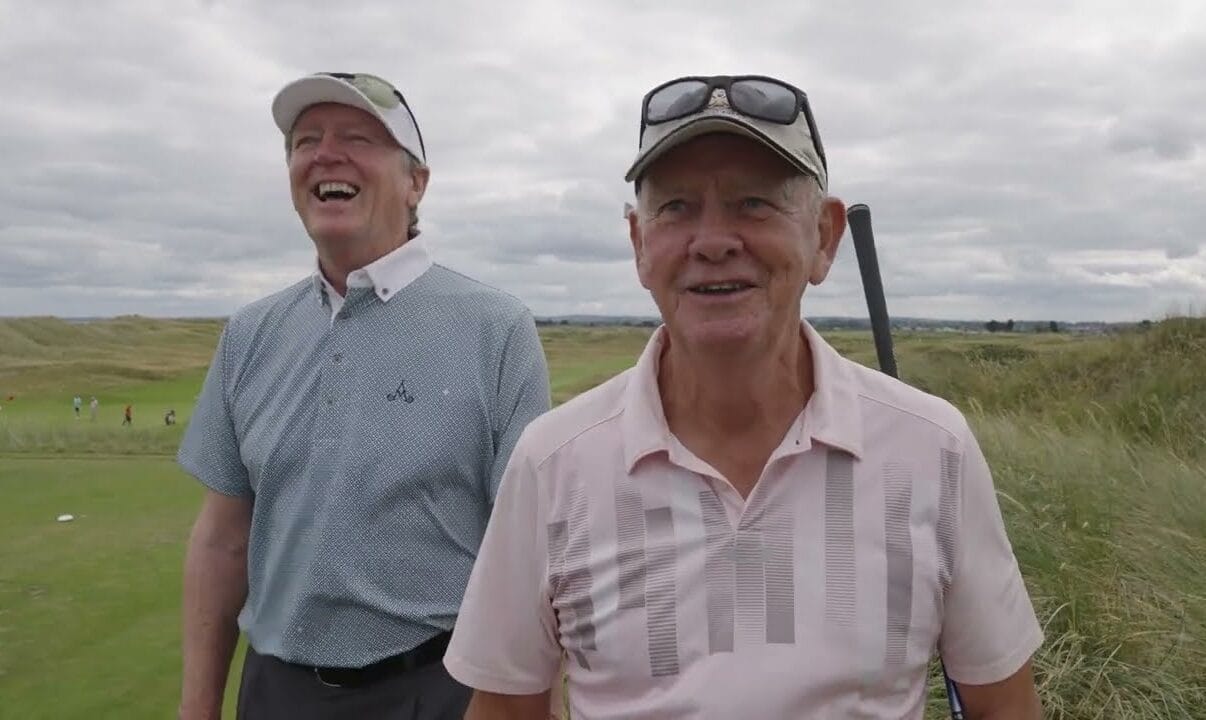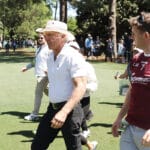When it comes to Irish sport, Carr is a name as synonymous with golf as Dunlop is with motorbike racing or Roche is with cycling. And the Carr name is at the forefront once again as Roddy Carr teams up with old sparring partner Des Smyth to co-host the 2023 Irish Legends at Seapoint from June 22-25, with Carr Golf, under the stewardship of Roddy’s brother, Marty, one of the leading investors who took over the club in 2021.
“It’s a great opportunity for me to get together with Des,” says Carr. “We travelled the tour together for five or six years a long time ago.
“He was one of my best friends on the tour and he went on to do the great things that he did while I had to go back to work, so it’s really a pleasure for us to come together and co-host the event.”
Carr’s golfing journey began earlier than most; his father Joe is one of the most celebrated amateur players of all time, making 11 appearances in the Walker Cup, and finishing eighth in the 1960 Open Championship despite his amateur status. Sure enough, Roddy was introduced to golf right from the start.
“We were born on the second green in Sutton,” he says. “Literally on the green, and we had 20 pints of milk delivered to the house every day to give you an idea of the traffic of people living there.
“People like John O’Leary, Jimmy Bowen and Robin Turnbull who played for Ireland, they all came and stayed for months at a time to be in that surrounding of golf with my father leading off every morning and hitting 200 balls before going to work. So, we played all of our golf around Sutton and it really was a magical place to grow up.”
As Roddy’s own career began to take off – he’d win the East of Ireland Amateur Championship in 1969, following up with a West of Ireland win in 1970 – he’d continue the Carr legacy in Walker Cups, taking his place on the 1971 side who’d deny the American’s a 13th successive victory as Britain and Ireland, thanks in no small measure to Carr’s three-and-a-half points from a possible four, recorded a memorable 13-11 victory at the Old Course at St. Andrews.
“I probably shouldn’t have even been on the team,” Carr concedes. “John O’Leary probably had a better record at the time but Michael Bonallack, who was my father’s really great rival, probably picked me because of my bloodline in being a Carr.
“He felt that I would deliver on the week, so I got chosen and he played me for the four days and I got my three-and-a-half points. I was probably at my peak then, because [Tom] Kite beat me in the quarterfinals of the Amateur [Championship] at Carnoustie and I was about 10-under-par for the week.
“But Bonallack trusted me and played me with experienced players. My father was there watching me, and I didn’t really want to see him watching me because he taught me everything I knew and I didn’t want to be thinking about what I should be doing, so my mother used to keep him hidden behind the gorse bushes when we were walking, but when I holed an 11-yarder on the last green to beat [Jim] Simons, he lost it and rushed onto the green and I’ll never forget the hug he gave me. It was a bit like Sam Torrance and the hug his father gave him at the Ryder Cup a few years later.”
Following his exploits at the Walker Cup and on the Irish and UK amateur circuits in the late 60s and early 70s, American university Wake Forest came knocking and offered a full scholarship which Carr turned down, later to describe as one of the biggest regrets of his life.
“To be honest, it was ignorance,” he’d humbly explain. “Jesse Haddock, who was the most famous coach in America flew over to Ireland to recruit me after we won the Walker Cup because we’d beaten [Lanny] Wadkins, Kite and [Steve] Melnyk and those on that team, but nobody knew what a scholarship was back in 1970. It never really got on the radar which is madness really.
“What American university golf teaches you is to play every week and get your scoring average down, whereas we were playing once every six weeks in tournaments. I reckon that would have made a difference to me because I went out on tour straight away and lost my confidence early and never regained it, whereas if I’d had another four years of grooming in that environment it might have been a different story.”
With his stature at all all-time high, instead, he’d head for the professional ranks where he’d join the stable of Mark McCormack at IGM, in a precursor for the career he’d pursue once his time on the European Tour had drawn to a close. One of the many sponsorships McCormack secured was with one of the milk companies, and adverts were splashed all over buses with Carr’s picture alongside and the caption ‘Milk’s a winner.’
“I’ll never forget what Des Smyth told me,” Carr laughs. “I wasn’t doing very well on the Tour and Des came up to me after about nine months and said, “I’ll have to tell you what the caddies are saying because you’re going to hear it anyway. They’re asking ‘What’s the difference between Roddy Carr and milk? Milk’s a winner.’”
“That was the kind of friend Des was because it was better hearing it from him, so yeah, I had a pretty rough time of it. ‘The Agony in the Garden’ I call it, because I spent ten years out there trying to make it work.”
The ability to consistently perform week in and week out in the professional ranks is a hurdle that many top-rated amateurs struggle to clear, and Carr never fully recaptured the form he’d shown in his last couple of seasons as an amateur.
It wasn’t all bad on tour though. European golf was on the rise in the 1970s, and there was a healthy Irish contingent on the circuit, and there was the sense that they were all part of the same family.
“It was fantastic fun,” Carr remembers. “You had everybody eating together every night. The Spanish went out, the Irish went out, the Australians went out, and they had a lot of fun.
“It wasn’t all the health stuff like today, we’d have a few jars and have a good time. There’re legendary stories of things that happened down the years with the Rhodesians and the South Africans especially, but there were some really great players as well and they’d have their fun but still go out and play great, great golf.
“In those days, you were carrying your own bag, you had your own practice balls, and you’d pick them up afterwards. Nobody could afford a caddie because you’d have to finish in the top-10 to make a profit, and you’d be staying in two or three-star places to try and get by.
“But it was probably a more enjoyable life than they’d have now, because they’re all professional athletes with trainers, coaches, mental guys, all of that backing them up so it’s a different kettle of fish completely.”
Towards the end of the decade, guys like Nick Faldo, Sandy Lyle, Bernhard Langer and Ian Woosnam all arrived on the scene, but it was the arrival of Seve Ballesteros that drove the tour to new heights and Carr, who would join IMG in a management capacity post-retirement from professional golf, would go on to manage Seve in the latter stages of his career.
“I actually had an incident with him that led to our working together many years later,” he said.
“We played together at the final event of the season at El Paraiso in Spain, and I needed to make the cut to keep my card and I ended up playing with this young fella, he was 16, and he walks onto the first tee. I knew he was Manuel’s brother but that’s all, and he introduced himself, ‘I am Seve,’ but other than that he didn’t have a word of English.
“Anyway, he played the first, hit one into about 10 feet, but kicked his bag all the way around the course and behaved atrociously. He ended up shooting 66, I shot 72. I was going to go and complain to Ken Schofield, the head of the Tour, and say I can’t play with this kid, but Manuel came over and talked me out of complaining about him, but I told him that he can’t expect to hole every 5-iron and every chip.
“Yes, he shot 66 and could’ve been 59, but still. Anyway, I didn’t report him, and we play together the next day and he was even worse, but I shot another 72 and ended up keeping my card so I let it go.”
Years later, having worked as an agent for IMG for several years, Carr would run into Seve again at the St. Andrew’s Hotel and deliver a proposition that would see Carr run events in Spain and with Seve attending, they’d split the profits.
“He looked me in the eye, as he would,” Carr recalls, “and he said, ‘You remember El Paraiso Roddy? You didn’t report me. We’ll make business.’
“And we did, we worked together for ten years, and I managed him for the last three. It was a great experience, and he was just something else. You’d have to live in Spain to understand the passion, the matador, how the heart works. You go into the ring and it’s just you and the bull and only one of you is coming out. That’s the way he saw it, win or die, that was Seve.”
Having spent the best part of 50 years in playing, management and tournament running capacities, it was only natural for Carr to spread his wings and he’d already been heavily involved in golf course architecture and design by that stage.
“I love the way that modern designers are becoming more minimalistic,” Carr explains.
“If you look at the best golf courses in the world, 80 of the top 100 were built 80 to 100 years ago because they had to work with mother nature and all the best designs nowadays are going back to that. Move less land, be more economical with the grass, the water and being environmentally friendly.
“And the thing I learned when I brought Jack [Nicklaus] to do Mount Juliet is to build a course that people can enjoy yet still remains challenging to the pros, and that’s what I’ve learned in the 30 years that I’ve been involved in that end of the business.”
And as Carr spends most of his time in Barbados these days, where he’s just completed working alongside Ron Kirby on the renovation of Apes Hill, and the construction of a par-3 course inspired by some of the most iconic holes in world golf, he finds himself playing more golf than ever.
“I’m playing better than I’ve played in about 30 years,” he says.
“I gave it up for about ten years completely but started back and I’ve been in Barbados for the last four years, so I’ve been playing more than ever. I play off three now, and I broke my age twice this year and that was my goal. I’m 72 and I shot 70.”
There’s no denying it, golf is in the blood, and blood is thicker than water.
Tickets for the Irish Legends are now on sale HERE
Footnotes…
Field of dreams for Irish Legends at Seapoint
Major winners Michael Campbell, Ian Woosnam and Paul Lawrie and defending champion Philip Price are joined by Irishmen Paul McGinley, Philip Walton, Gary Murphy, David Higgins and Brendan McGovern, along with big international names such as Thomas Levet, Niclas Fasth, Jeev Milkha Singh and Jarmo Sandelin.
Irish soccer legends Shay Given and Ronnie Whelan will feature in the celebrity Pro-Am, along with fellow footballer Teddy Sheringham, with former World Snooker Champion Ken Doherty, Irish rugby legend Keith Wood, actor James Nesbitt and record-setting Dublin manager Jim Gavin also in attendance.
The Upgrades at Seapoint
Under Carr Golf’s stewardship, over €1 million has been spent on refurbishment, including a new roof, flooring, windows, and doors, along with a complete interior overhaul of the clubhouse and revetted bunkering on the Des Smyth designed course.
The charitable aspect
The Louth/Meath branch of Down Syndrome Ireland, based in Drogheda, are set to benefit from the Irish Legends, making it a wonderful event for the community at large.
























Leave a comment